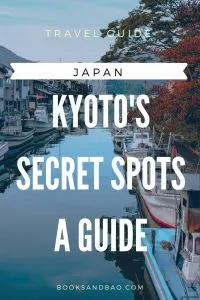Kyoto is a wonderful city and visitors to the area tend to have more than enough to see for a flying visit, like the famed Fushimi Inari, the geisha of Gion, and the majestic Golden Pavilion.
That’s not to mention the thriving art culture that’s present in the city. From boutique shops to art galleries and hipster cafes, creativity is far from lacking in Japan’s old capital.
Enjoy Kyoto’s off-the-beaten-track areas
That being said, there’s a whole prefecture outside of the city just waiting to be explored. ‘Greater Kyoto’, as I like to call it, is where you’ll find authentic Japanese culture, secret spots, breath-taking views, and really get a chance to meet local people.
Read More: 24 Hours in Higashiyama – Kyoto’s Cultural Centre

For this guide, we’re heading to the north of the prefecture, just 130 kilometers from the city; an area which could easily be described as Kyoto by the Sea since you’ll be enjoying stunning coastal views the whole way.
The region consists of seven key cities and towns: Kyotango, Ine-cho, Yosano-cho, Miyazu, Maizuru, Ayabe, and Fukuchiyama. Here are some of the key places to visit within those areas and how to get there.
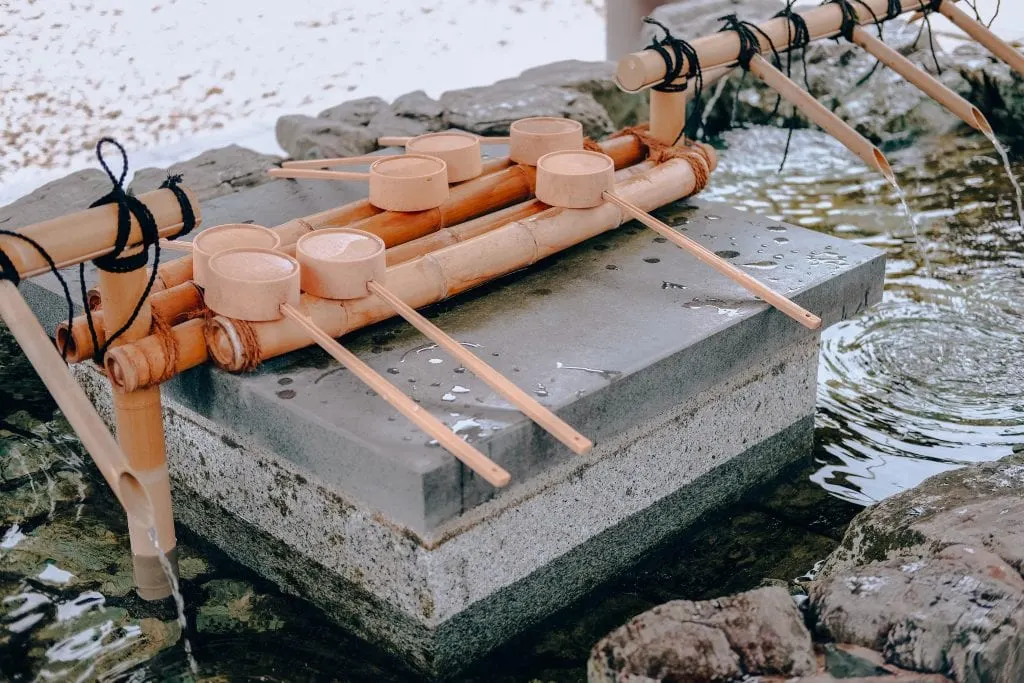
Amanohashidate
Amanohashidate is renowned as being one of Japan’s Scenic Trio (Nihon Sankei 日本三景). The other two scenic sites being in Miyajima (vermillion torii on the ocean) in Hiroshima and Matsushima (pine tree islands) near Sendai, Miyagi Prefecture.
The area is centred around a 3.6km long sandbar created thousands of years ago by opposing ocean currents and is well worth a visit. You can walk across it or rent a bicycle and ride across in about 10 minutes.
You’ll notice people with their head between their legs while you’re there and it’s easy to question what you’ve missed and maybe you should just copy them.
Luckily, I can share what I found out – if you view it upside down (especially from Kasamatsu Park) it’s supposed to look like a bridge to heaven, which, incidentally, is exactly what “Amanohashidate” means.
To get the best view of the area, head to the cable car at Kasamatsu Park, you can even take a chair lift down instead of the cable car for some amazing shots.
Amanohashidate Cable Car / Chair Lift (Fuchu Station) to go up to Kasamatsu
Park.
Round trip: ¥660 for adults, ¥330 for children
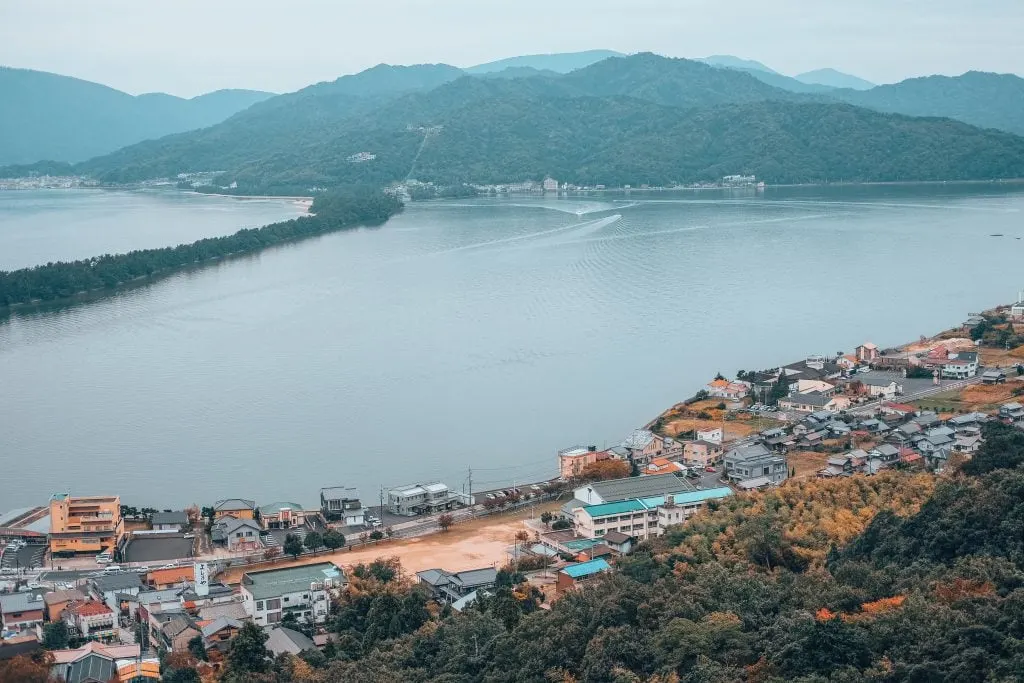
An extra thing to do nearby:
Moto-Ise Kono Shrine (元伊勢籠神社)
Ise Grand Shrines (Ise Jingu) in Mie Prefecture are Japan’s most sacred Shinto shrines. They are dedicated to the Sun Goddess Amaterasu (Shinto’s most important goddess, and legendary ancestor of the Imperial family) and Toyouke-Omikami (豊受大神), goddess of agriculture.
Before Ise Jingu was established around the 7th century, a number of shrines for these two deities were temporarily established in various locations, including this Kono Shrine.
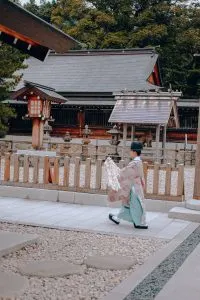
Free admission
Open: 7:00–17:00
Directions: The closest train station is Amanohashidate Station (Kyoto Tango Railway). From there, take a local bus bound for Ine, Kamanyu, or Kyogamisaki ([伊根・亀島] [蒲入] [経ヶ岬]) and get off at Jinja-mae stop.
If you like cycling then you can rent a bicycle and ride across Amanohashidate to the other end. Bicycles can be rented at a souvenir shop in front of Amanohashidate Station and at the entrance of Amanohashidate sandbar.
Read More: 5 Best Museums in Osaka
Maizuru
Maizuru has been a navy town since 1901. It was a key naval base during the Russo-Japanese War (1904–05). Today, it is home to the Japan Maritime Self-Defense Force’s Maizuru navy base.
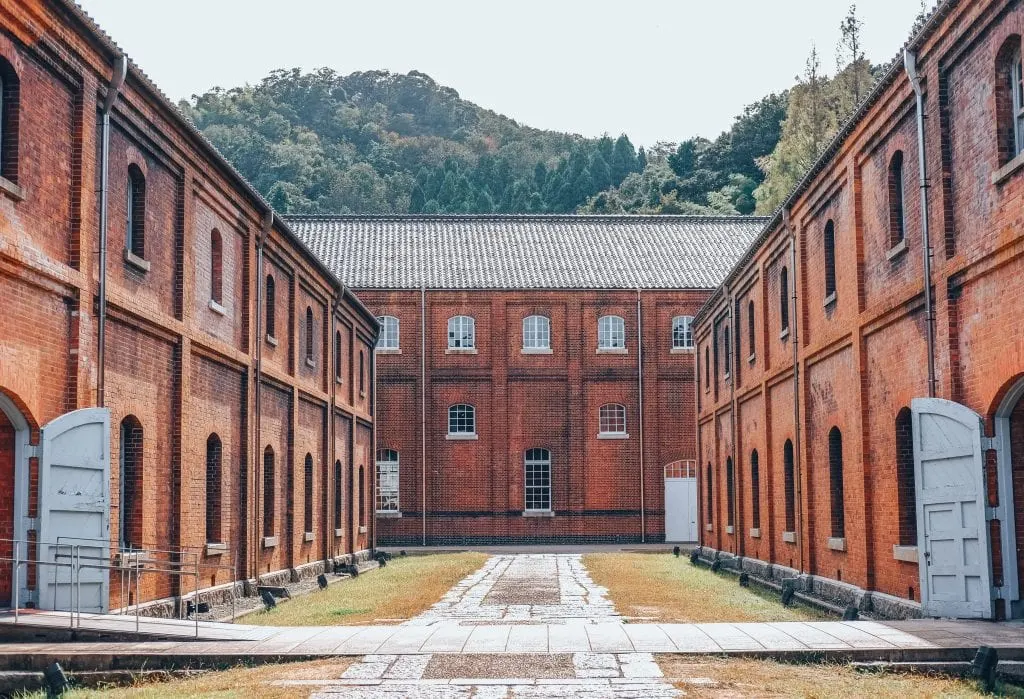
The Maizuru Brick Park
A must-visit while in the area, The Maizuru Brick Park stands as a testament to the rapid militarization in the early parts of the twentieth century. After the Japanese navy base was built in 1901, many brick buildings in Maizuru were rapidly built for the Japanese navy to store munitions (arsenal).
You can visit twelve of the brick buildings, of which eight are National Important Cultural Properties. You can explore inside, visit the coffee shop, and admire the exhibits and galleries they have within.
Address: Maizuru Brick Park
Kitasui 1039-2, Maizuru-shi, Kyoto
Map: https://goo.gl/maps/ZuFd1eXrNds
English pamphlet pdf: http://akarenga-park.com/wp/wp-content/themes/karappo_standard/assets/pdf/english.pdf
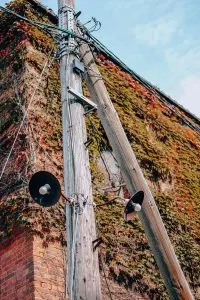
Where to eat: Shoeikan (松栄館)
A relatively new restaurant which opened in late 2018, originally the annexe of the Shoeikan ryokan inn which opened in 1904. It’s unsurprising that period films have been shot here as it genuinely feels like you’re dining in the past.
The restaurant’s menu is very reasonable, and prices range from ¥900 for a meal and ¥4,500 for a full course.
A delicious and hearty selection, British people will be particularly happy here since many of the dishes are reminiscent of our home-cooking.
For example, nikujaga, a meat, potatoes and onion dish (whose name literally means ‘meat and potatoes’) that is very popular in Japanese households is very similar to the classic stews our mothers make in the UK.
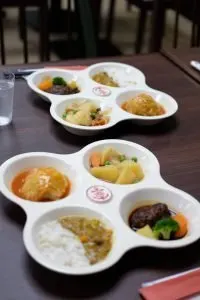
Our personal favourite dish, Japanese curry and rice, is also very similar to the curries we enjoy back home (although Japanese curries are far superior in our humble opinion).
Why the similarities, you ask? The British navy who were originally stationed in Maizuru a century ago left recipes behind to share with the locals, recipes which have been adapted into Japanese home cooking today.
Shoueikan specializes in a special kind of cuisine, called yoshoku, imitating recipes that were recorded in a Meiji-era navy recipe book of over 200 Western inspired recipes.
Hours – Lunch: 11:30–14:30/ Dinner: 17:30–21:30
Directions
About 1 km from JR Higashi Maizuru Station. Parking available. Also within 1 km to Maizuru Brick Park.
Map: https://goo.gl/maps/sQd8ZdekJqA2
Address Shoeikan, Hama 18, Maizuru-shi, Kyoto
An extra thing to do nearby:
If you have a car or organise some sort of private transport, then this stunning spot is well worth your time.
Read More: How to Spend a Perfect Day in Daimyo, Fukuoka
Yoshihara Irie Inlet (吉原入江)
This beautiful waterfront fishing neighbourhood is a photographer’s dream. With boats moored right outside and Venice like canals, this fishing village has been operating since the Edo Period.
There’s not much to do in the area aside from walking around, taking pictures, and to try and have a chat with the locals. But with views like this, who needs anything more?
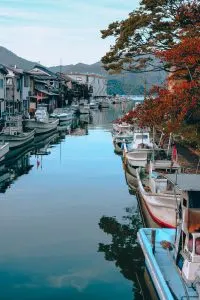
Address: Yoshihara Irie Inlet
Route 565, Higashi-yoshihara, Maizuru-shi, Kyoto
京都府舞鶴市東吉原 府道565号線
Map: https://goo.gl/maps/2zZPb3jvhDN2
Ine
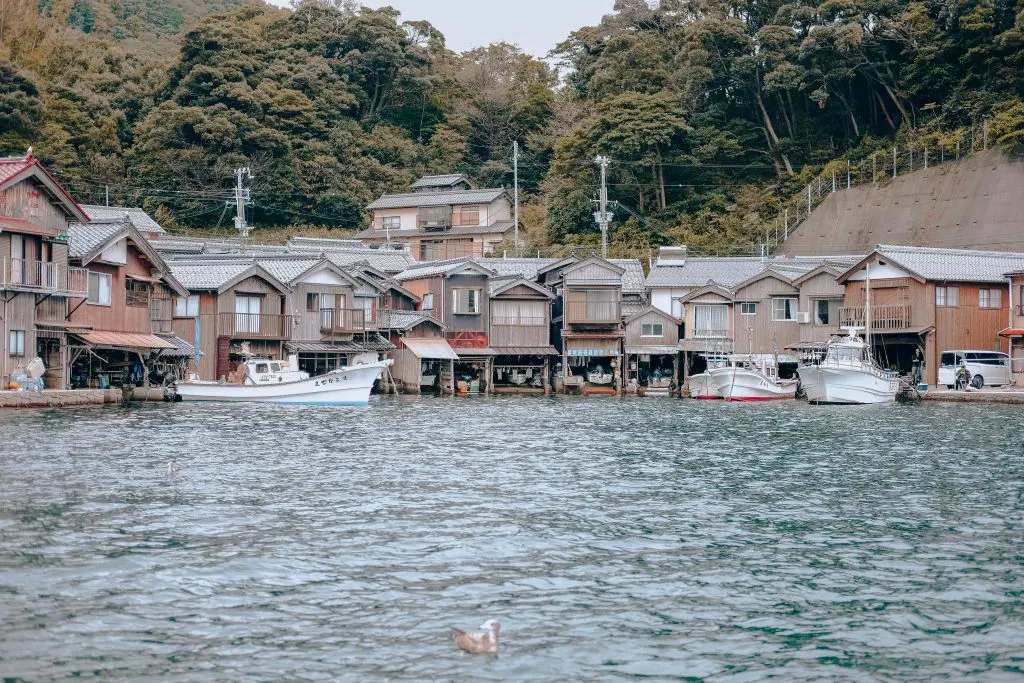
A truly undiscovered gem in Kyoto, it’s a rural seaside town with 230 gorgeous funaya buildings over a five-kilometre stretch of coast. You can take a boat trip around the lake and take incredible shots or just simply enjoy the atmosphere of the village. This was one of my favourite places on the whole trip.
There’s a lot to do in the area since younger generations are returning to Ine and opening inns, cafes, and restaurants within the funaya. This is an amazing place to try the local fish dishes since everything is freshly caught.
Read More: I will keep it short here since we have a whole post dedicated to this area right here. Enjoy!
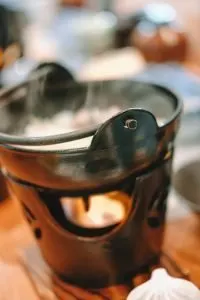
Japanese Oni Exchange Museum
One of my favourite things we saw on the trip was the oni museum in Fukuchiyama explaining and exhibiting everything oni (a kind of demon or ogre) from masks to statues, and paintings from Japan and overseas. Set at the foot of Oeyama mountains, mountains famous for their oni legends.
Directions
15 min. by taxi from Oe Station (Kyoto Tango Railway).
Map: https://goo.gl/maps/BPYUCzJwBaN2
Address
Japanese Oni Exchange Museum
Busshoji 909, Oecho, Fukuchiyama, Kyoto
〒620-0321京都府福知山市大江町仏性寺909
Where to stay:
We chose a combination of homestay and ryokan (traditional Japanese hotel) since we wanted the best of both worlds.
An intimate experience with a local family is priceless when you travel and this as no different as we stayed up eating and drinking with the elderly couple who hosted us and even got to help make the rice in a traditional pot on a fire.
There are a number of homestays in the area known as Ayabe Farmhouse Lodges. They have a website in Japanese but I’d definitely recommend getting in touch with the tourism board to help you book. They’re very helpful!
Shorenkan Yoshinoya
The ryokan allowed us some much needed time in the onsen after all of our travels. The indoor and outdoor onsen in this ryokan are stunning – check out these pictures and since the ryokan only houses 22 guests the chances of getting it to yourself are very high. They also didn’t mind my tattoos – hurrah.
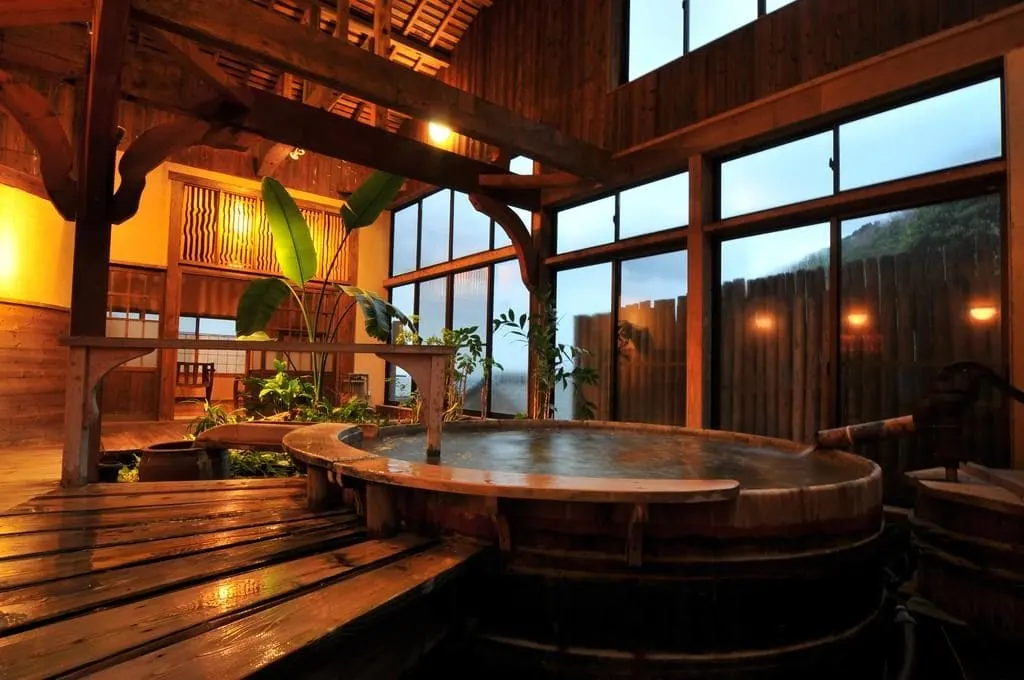
Here we enjoyed a traditional ryokan meal which always lasts hours with small courses allowing you to reminisce on your day. There’s a beautiful shared lounge downstairs where you can take coffee and you’re also provided with yukata to wear for your stay which is perfect for taking pictures in.
The nearest station is Amino Station (Kyoto Tango Railway). Then the ryokan can pick you up at the station for free.
How to get to these places:
It’s very possible to travel to these areas via public transport from Tokyo, Osaka or Kyoto.
The main gateway to northern Kyoto is Fukuchiyama Station in Fukuchiyama. Trains from JR Osaka Station (via JR Fukuchiyama Line) and JR Kyoto Station go to Fukuchiyama Station.
You can also go from Tokyo Station to JR Kyoto Station and start there.
From Fukuchiyama Station you can then use the Kyoto Tango Railway and JR San’in Line – you can also easily reach Maizuru, Miyazu, and Amanohashidate from here.
You can then use this tourist map to guide you regarding buses and local trains. Again, if you’re stuck the tourism board will be very happy to help you.
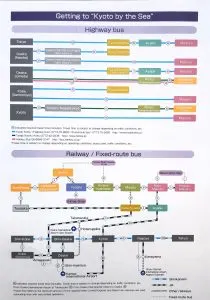
If you’re travelling around Japan, don’t forget your JR Pass. Trains are expensive!
If you’re visiting Tokyo, check out our city guide.
